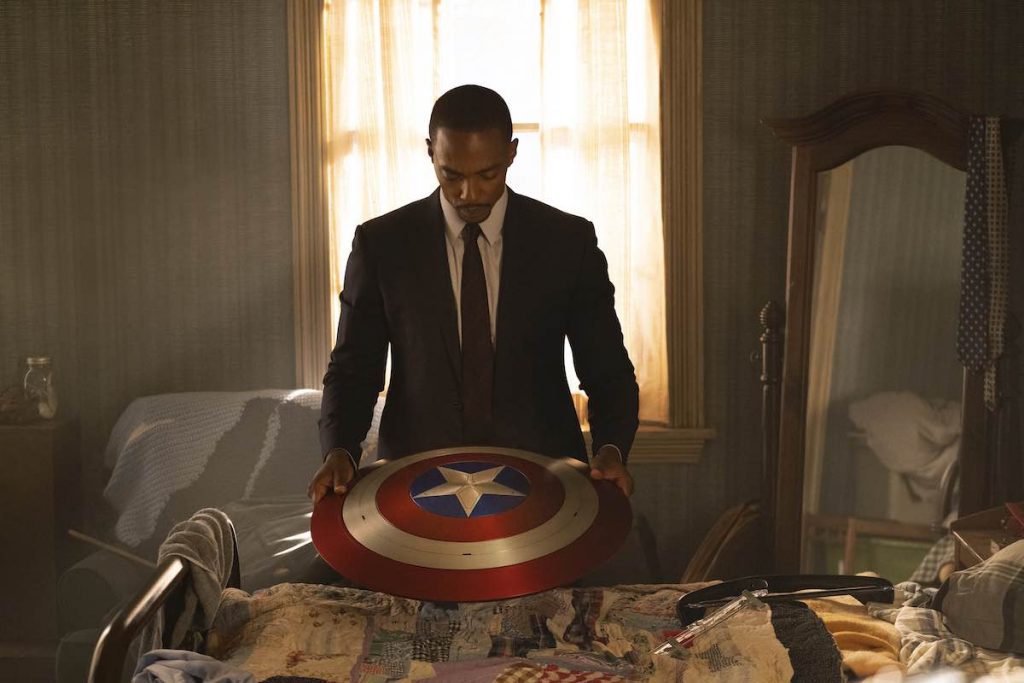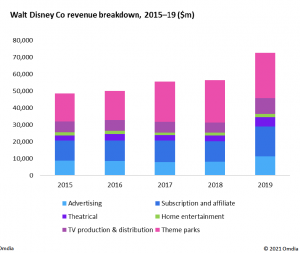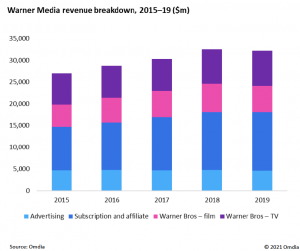
After more than 35 years of operation, TBI is closing its doors and our website will no longer be updated daily. Thank you for all of your support.
TBI Tech & Analysis: How Disney & WarnerMedia prepared for streaming wars
A fortnight ago, TBI Tech & Analysis reflected on the transformative moves into DTC streaming by US studios. Now, Omdia’s senior research manager Tim Westcott provides a potted history of how two of the biggest operators – Disney and WarnerMedia – realigned their operations to take on Netflix.
It was only in 2018 that Walt Disney Co ended its US output deal with Netflix, paving the way for the launch of D2C service Disney+ in November 2019.
Disney had already acquired most of the film and TV assets of 21st Century Fox in 2018 in a $71bn deal, significantly expanding its portfolio of channels and film and TV library. In a 2018 results call, CEO Bob Iger said Disney planned to reorganise even before the Fox acquisition along the lines of global online platforms like Netflix.
“It became clear that we could be organised not only in a more efficient way, but in a more modern way to take into account how our businesses have been transformed by technology,” he said.
Disney+, whose upcoming series include Marvel’s Falcon And The Winter Soldier, launched in the US and Canada in November 2019, rolling out to other countries including Western Europe and India since then.
The D2C service has far exceeded Disney’s expectations, with the company last week revealing it had secured more than 100 million paid subscribers. Disney also has majority control of the US online SVoD service Hulu and is also launching another D2C service using the Star brand in 2021.
Channel closures & a global outlook
Disney has closed some of its linear pay channels in countries where it has launched Disney+, including Australia, New Zealand, and the European “big five.” This is likely to herald further channel closures by Disney as it shifts to D2C.
Whether other studios will follow suit is debatable: children’s and family content is well suited to on demand, and channels with this content can struggle to gain carriage fees from operators. Disney was left with a portfolio of more than 100 channel brands after the Fox deal.
In October 2020, Disney unveiled a “strategic reorganisation” of its media and entertainment business, centralising distribution and commercialisation of its content into a single global organisation, alongside three content groups handling film, TV, and sports production.
HBO Max attack
Telecoms giant AT&T, in the US at least, been every bit as combative as Disney towards Netflix. It completed the $85bn acquisition of Time Warner in June 2018, bringing HBO, Turner, and Warner Bros. under the same roof as the group’s telecoms services and the DirecTV pay-TV platform.
Randall Stephenson, CEO of AT&T, previously said his company would “bring a fresh approach to how the media and entertainment industry works for consumers, content creators, distributors, and advertisers”. He also spoke before the launch of HBO Max about taking back Warner Media-owned content from other platforms.
The most high profile example was Friends, which was moved exclusively to HBO Max from launch in May 2020. HBO archive series like Boardwalk Empire and Curb Your Enthusiasm also returned from Amazon. In its 2019 accounts, AT&T included a $1.2bn cost for WarnerMedia forgoing licensing revenue to assist the launch of HBO Max.
Subscription & reorg
WarnerMedia said HBO Max and HBO had a combined 41.5 million subscribers in the US in Q4, with the US studio recently revealing a new target of between 120 million and 150 million subscribers by the end of 2025.
Outside the US, the D2C platform’s rollout is more nuanced. Initially, it will be offered only in countries where the HBO brand is also present: Latin America, parts of Europe, and Asia & Oceania. HBO’s long-term output/co-pro deal with Sky in Europe remains in place, which appears to rule out a launch in these countries until the deal expires.
In a major reorganisation, a new HBO Max operating unit is being created to elevate the streaming service within the organisation and step up its global rollout; all film and TV studios will be combined into a new Studios and Networks group; a new international unit will manage international activities of Warner Bros, HBO, and Turner, and a new commercial unit will combine US ad sales and distribution teams with home entertainment and licensing.
The excerpt above comes from Broadcaster Transformation – The Studios, an Omdia report written by Tim Westcott, Senior Research Manager, Channels, Programming and Advertising. To read last week’s overview of the US studios’ moves to DTC, click here.





